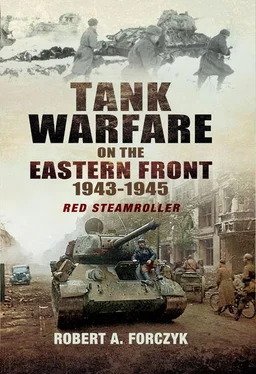Operation Zitadelle : The Northern Front 5–10 July 1943
Generaloberst Walter Model, commander of AOK 9, was not sanguine about Zitadelle ’s chances for success, since he knew from aerial reconnaissance about the extent of enemy defences being prepared by Rokossovsky’s Central Front. Indeed, Model presented this information to Hitler and tried to personally dissuade him from launching the offensive. Instead, Model argued that the Germans should remain on the defensive and create a strong mobile reserve that would allow them to smash any Soviet offensives. Yet Hitler would not be diverted from this battle and Model accepted his role, but planned his part of the operation with particular attention to preserving his own armour. At best, Model would have 800 tanks and assault guns to commit to the offensive and he knew that losses in a breakthrough attack would be heavy. Instead of von Manstein’s armour-heavy approach to Zitadelle , Model intended to rely more upon his infantry divisions, artillery and air support to crack the Soviet defences and only commit his armour when he saw an opening that could be exploited. Furthermore, Model also knew that the Soviet Bryansk and Western Fronts were planning to attack the Orel Salient as they had done in February–March, so he wanted to keep as much of his armour intact as possible to deal with this contingency. To Model, retaining Orel was more important than taking Kursk.
Opposite Model’s AOK 9, Rokossovsky had placed General-leytenant Nikolai P. Pukhov’s heavily-reinforced 13th Army in the Ponyri sector where he expected the Germans to attack. Pukhov’s army held a 22km-wide sector and had four rifle divisions holding the first line of defence, two more holding the second line and six in the third line. The Soviet defences were built around entrenched rifle battalion strongpoints, enclosed by mines and protected by anti-tank guns. Each Soviet position incorporated all-around defences and was intended to hold out if surrounded – this type of reinforced hedgehog tactic was intended to function as a ‘wave breaker’ type defence. For infantry support, Pukhov had 178 tanks and 49 self-propelled guns, although most were kept back in the second or third lines of defence. The 13th Army’s best armoured units were the 129th Tank Brigade with 49 tanks (incl. 10 KV-1 and 21 T-34) and the 27th and 30th Guards Tank Regiments (GTR) with a total of 44 KV-1s heavy tanks. In general support, Rodin’s 2TA (consisting of the 3rd and 16th Tank Corps and 11th Guards Tank Brigade) was in reserve 25km south of the forward edge of the battle area. Rodin had a total of 305 T-34s and 142 light tanks. Rokossovsky also kept the 9th and 19th Tank Corps, which had a total of 232 T-34s and 148 other tanks, under front control.
During the night of 4–5 July, Model’s army began its final preparations for the offensive by sending sapper teams forward to begin clearing lanes through the first layer of Soviet minefields. One team was ambushed and a prisoner revealed under interrogation that Zitadelle would begin at dawn. Zhukov, who was present in Rokossovsky’s command post, pressured him into unleashing an artillery bombardment to disrupt the German offensive. However, the unplanned Soviet artillery barrages had limited effect on German front-line units and the German artillery preparation began at 0425 hours and continued until 0545 hours. Model launched supporting attacks with three infantry divisions from XXIII Armeekorps on his left flank and three infantry divisions from XXXXVI Panzerkorps on his right flank; despite support from three Sturmgeschütz-Abteilungen, these efforts only advanced a few kilometres before being stopped by Soviet resistance and failed to achieve their objectives.
Model’s main effort was made in the centre, with General der Panzertruppen Josef Harpe’s XXXXI Panzerkorps and General der Panzertruppen Joachim Lemelsen’s XXXXVII Panzerkorps. Harpe attacked along the Orel-Kursk rail line near Maloarkhangel’sk station, close to the boundary between Pukhov’s 29th and 15th Rifle Corps. Oberstleutnant Baron Ernst von Jungenfeld’s schwere Panzerjäger Regiment 656 was split up, providing a battalion of Ferdinands each in direct support of an infantry regiment from the 86.Infanterie-Division, while Sturmpanzer-Abteilung 216 followed in general support. Each battalion of Ferdinands was preceded by a Panzerkompanie (Fkl) with BIV demolition vehicles to clear a path through the enemy mines. [19]The Germans had not put a great deal of effort into developing armoured mine clearing tanks, unlike the British who fielded the Matilda flail tank (Scorpion) in October 1942 or the Red Army, which first used PT-34 mine roller tanks in the summer of 1942. Instead, the Germans opted for an ad hoc solution using vehicles intended to demolish bunkers, not mines, and the results were mediocre. Nor had the AOK 9 conducted realistic breaching drills with BIVs, tanks and infantry prior to Zitadelle – a major omission. As the BIV vehicles approached the Soviet defences around 0600 hours, they were met by a deluge of artillery fire that destroyed seven BIVs. Instead of clearing three lanes through the mines, the German pioniers only managed to clear a single narrow lane. The defending Soviet 410th Rifle Regiment, which had ample artillery and anti-tank support, kept this cleared lane under very heavy fire and prevented the pioniers from expanding it. Amazingly, the Germans did not use smoke to provide concealment for the breaching teams. All the while, the Ferdinands and StuG IIIs from Sturmgeschütz-Abteilung 177 provided fire support to the pioniers, but could not suppress the enemy defences.
With the main German attack on the verge of collapse, the Ferdinands were ordered to move through the cleared lane and overrun the enemy defences. The Ferdinand was designed as a long-range tank destroyer, not an assault vehicle. Its 200mm thick frontal armour was virtually impregnable to 76.2mm gunfire, but its tracks had no special immunity to mines and the 70-ton vehicle was very slow. Inside their buttoned-up Ferdinands, the German crewmen only had a vague idea where the cleared lane was through the smoke from burning steppe grass and explosions, which caused many of them to roll over mines. Some suffered track damage and were immobilized, but one Ferdinand struck five mines and kept rolling. However, the shock of mine explosions damaged the batteries in many Ferdinands, for which no replacements were available in AOK 9. On the first day of the offensive, the Ferdinands had 30 batteries destroyed by mine damage, sidelining these vehicles for many days. {83} Eventually, a few Ferdinands and StuG IIIs made it through the lane and began to reduce the Soviet defences at point-blank range. The Soviet 15th Rifle Corps commander committed his armoured support, consisting of 34 KV-1 heavy tanks, 21 T-34s, 18 light tanks and 16 Su-122s.
Harpe also committed General-major Karl-Wilhelm von Schlieben’s 18.Panzer-Division and the 292.Infanterie-Division to clear out the area west of the rail line. Von Schlieben’s division was severely understrength, with only 72 tanks, most of which were older models or the Pz III Ausf N version with the short 7.5cm infantry support howitzer. The division’s panzergrenadiers started Zitadelle with just 22 SPWs. Lacking firepower and mobility, Harpe used the 18. Panzer-Division as a mop-up force to clear bypassed Soviet strongpoints, rather than as an exploitation force. After hours of fighting, Harpe’s corps finally managed to advance about 4km by nightfall, but it had not completely eliminated the enemy first line of defence in its sector.
On Harpe’s right flank, Lemelsen’s corps attacked the 15th Rifle Division (15RD) with the 6.Infanterie-Division, supported by the Tigers of Major Bernhard Sauvant’s s. Pz.Abt. 505. Here, the BIVs also had difficulty clearing lanes and six of Sauvant’s 31 Tigers were damaged by mines in the opening minutes. Army and Division boundary lines are acknowledged as tactically vulnerable areas since, if inter-unit coordination is not properly done, an enemy can sometimes find or create an opening. Pukhov’s left flank was held by the 47th Rifle Regiment of 15RD, which had been badly disrupted by the German artillery preparation and had lost wire communications with its division command post. The German infantry from 6.Infanterie-Division were able to create a breach in this sector and after two hours, Lemelsen sent Generalmajor Mortimer von Kessel’s 20.Panzer-Division forward to exploit the opening. [20]Kessel moved a mixed Kampfgruppe through the breach, which included his only company of SPWs and some medium tanks. Once through, the Kampfgruppe moved through dead space (i.e. not visible from the enemy positions) and managed to get through a small gap in the enemy defences and outflank one of the 47th Rifle Regiment’s battalion strongpoints. A rapid Panzer assault, supported by Sauvant’s Tigers, infantry and artillery, succeeded in overrunning this one position, which soon led to an unravelling of the 15 RD’s forward line of defence and a panicked retreat by another battalion. One Soviet battalion strongpoint held out as ordered, but was bypassed and encircled by 6.Infanterie-Division. While mopping up continued, Sauvant was level-headed enough to take advantage of the disruption in the enemy defence and he pushed south with his Tigers and two small Kampfgruppen from 20.Panzer-Division. He succeeded in partially overrunning the 15 RD’s second line of defence and surprised an anti-tank position in the town of Soborovka. The Soviets committed the T-34s of 237th Tank Regiment to block any further advance. By this point, Sauvant was low on fuel and ammunition and decided to halt, but he had a good day and his advance of 8km was AOK 9’s furthest penetration on the first day of Zitadelle .
Читать дальше








![John Stieber - Against the Odds - Survival on the Russian Front 1944-1945 [2nd Edition]](/books/405234/john-stieber-against-the-odds-survival-on-the-russian-front-1944-1945-2nd-edition-thumb.webp)



